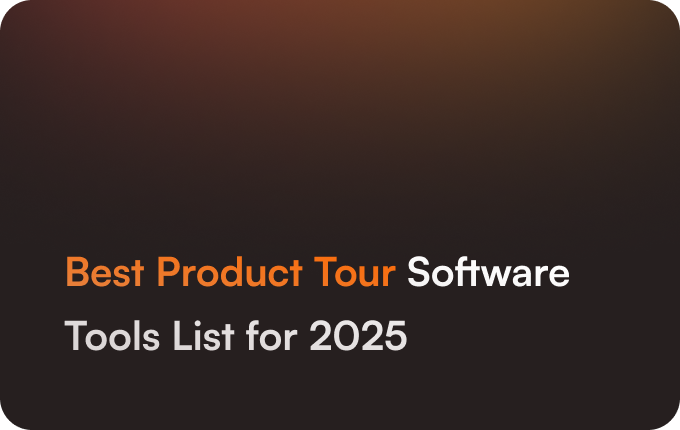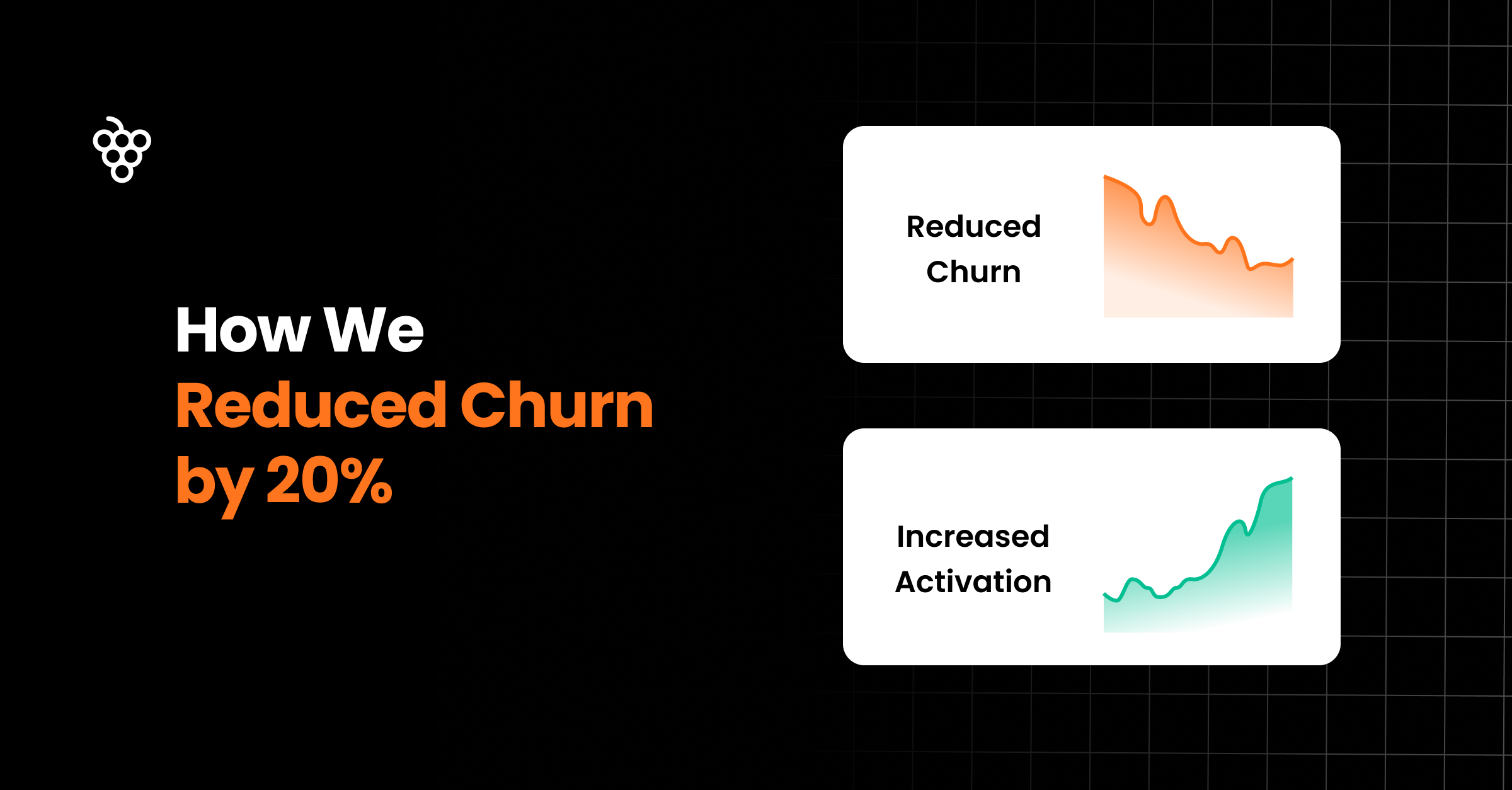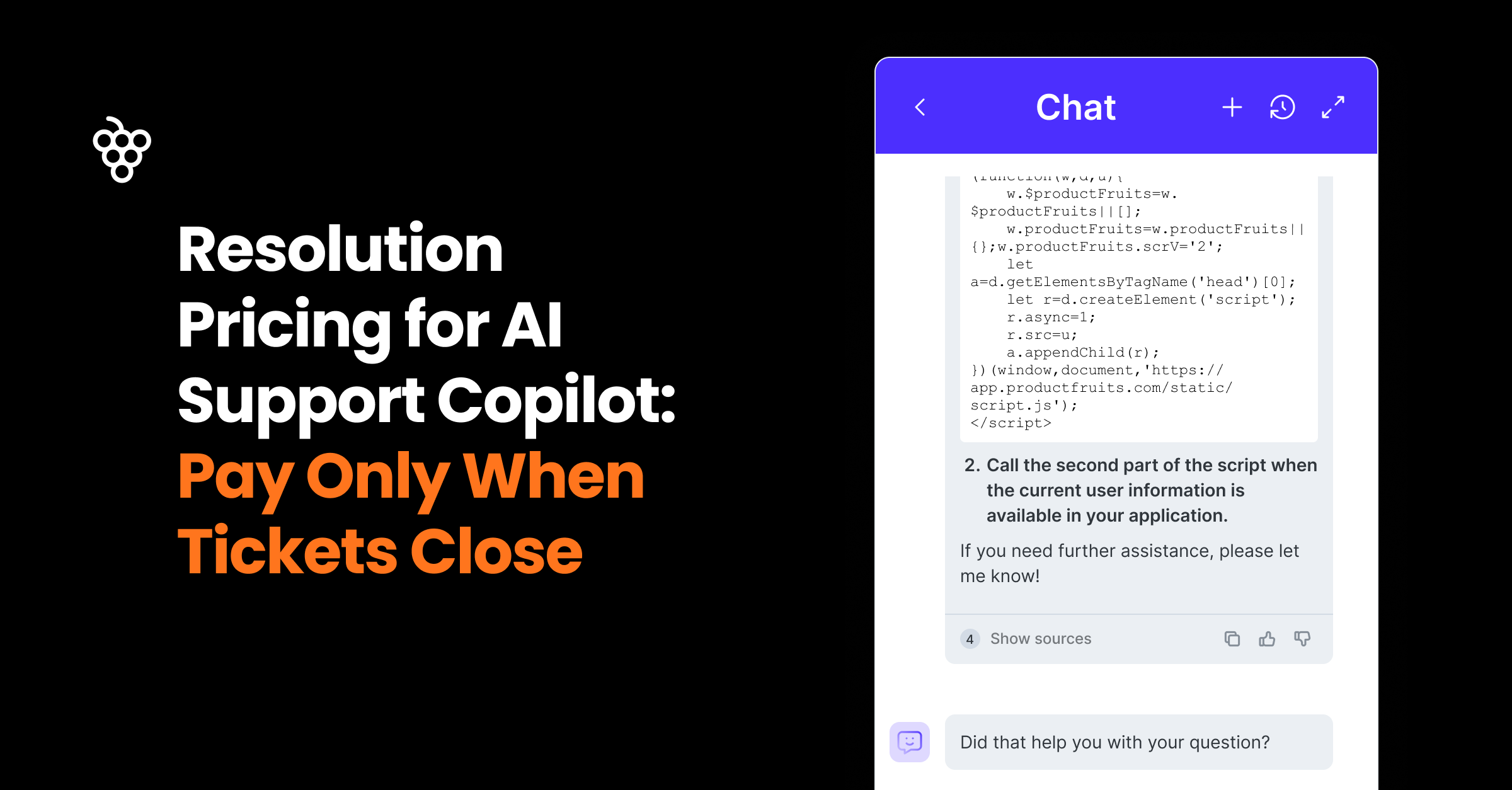
Product Onboarding: Steps, Best Practices, and Real-World Examples


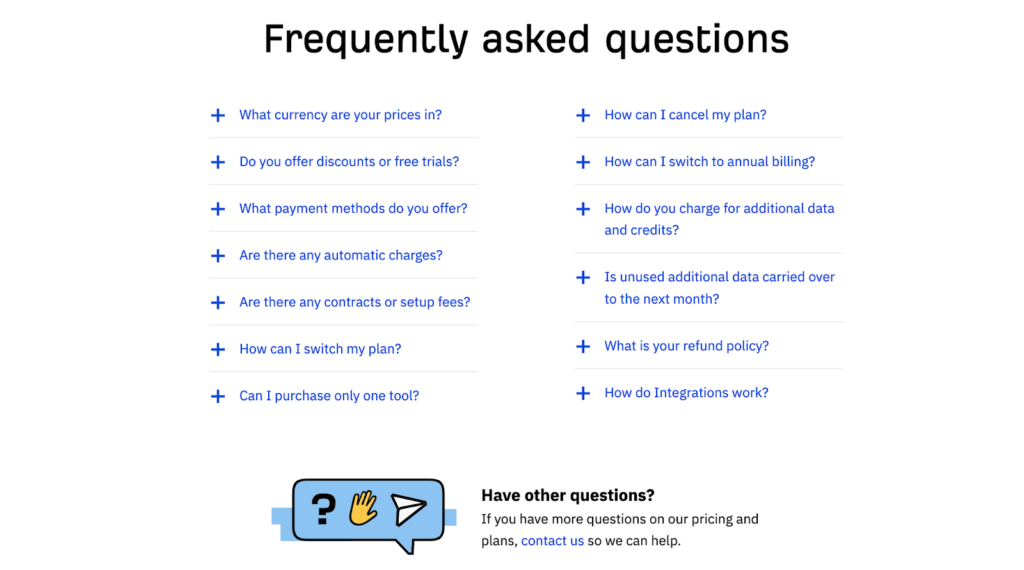
Product onboarding is the gateway to customer success in SaaS. A seamless onboarding experience ensures users quickly understand your product, see value early, and stay engaged long-term. It’s not just about introducing features—it’s about guiding users toward meaningful outcomes that drive long-term product adoption. Here’s why effective onboarding is crucial:
- Reduces Churn – Users who struggle during onboarding are more likely to abandon the product. A structured onboarding flow helps retain them by preventing early drop-offs.
- Accelerates Time-to-Value (TTV) – The faster customers experience value, the more likely they are to activate and continue using the product. Personalized onboarding paths can speed up this process.
- Boosts User Adoption – Intuitive onboarding, powered by interactive walkthroughs, contextual tooltips, and in-app guidance, enhances engagement and product stickiness.
- Improves Customer Satisfaction – A frictionless start builds confidence, strengthens user trust, and enhances the overall experience.
- Enhances Expansion & Revenue Growth – Engaged users are more likely to upgrade, refer others, or expand usage, making onboarding a key driver of product-led growth.
For SaaS businesses, onboarding isn’t just about guidance—it’s a strategic process that improves activation, retention, and long-term revenue potential.
What is Product Onboarding?
Product onboarding is the structured process of introducing new users to a SaaS product and helping them achieve success as quickly as possible. It encompasses everything from the first interaction—sign-up, welcome screens, and guided walkthroughs—to feature adoption, engagement, and long-term retention. A well-optimized onboarding process reduces friction, shortens the learning curve, and increases customer lifetime value (LTV).
Product Onboarding vs. User Onboarding
While often used interchangeably, product onboarding and user onboarding serve different functions:
- Product Onboarding – Focuses on the entire onboarding system, ensuring that different customer segments experience a smooth, value-driven journey from trial to activation.
- User Onboarding – A more personalized approach that tailors the onboarding process to individual users based on their goals, roles, or use cases.
A robust product onboarding strategy integrates both—providing a structured framework while offering contextual, role-based guidance to drive better user adoption.
How Onboarding Ties into the SaaS Growth Flywheel
Traditional SaaS models relied on linear funnels, where marketing acquired customers, sales closed deals, and customer success worked on retention. But the modern SaaS growth flywheel is customer-driven and momentum-based—where onboarding plays a pivotal role in reducing friction, increasing retention, and accelerating expansion.
- Activation fuels retention – A strong onboarding experience helps users achieve early success, which keeps them engaged.
- Retention drives expansion – Engaged users not only stick around but also explore more features, upgrade plans, and expand usage.
- Satisfied users power acquisition – Happy customers become advocates, fueling organic growth through referrals and word-of-mouth.
In short, product onboarding isn’t just a one-time experience—it’s a recurring cycle that powers SaaS growth by continuously improving activation, adoption, and advocacy.
Why is Product Onboarding Important?
An effective product onboarding process is crucial for driving activation, improving retention, and maximizing customer satisfaction. It ensures users quickly understand the product, experience its value, and engage deeply, reducing friction and increasing long-term adoption.
1. Impact on Retention, Activation, and Customer Satisfaction
- Drives Activation & Engagement – Onboarding guides users through the learning curve, helping them experience the product’s core benefits faster. This accelerates freemium-to-premium conversions and prevents early disengagement.
- Improves Retention & Lowers Acquisition Costs – A well-structured onboarding process keeps users engaged, reducing churn and increasing customer lifetime value (LTV)—leading to lower acquisition costs in the long run.
- Boosts User Engagement & Self-Sufficiency – Educating users through interactive walkthroughs, in-app guidance, and onboarding checklists empowers them to navigate the product with little or no assistance, reducing support tickets.
- Enhances Customer Satisfaction & Loyalty – Users who can seamlessly explore and utilize the product become long-term, loyal customers, resulting in higher Net Promoter Scores (NPS) and stronger advocacy.
Key Stat: Research shows that effective onboarding can increase trial-to-paid conversion rates by up to 60% while significantly reducing churn.
2. Psychological Triggers That Drive Engagement
The most effective onboarding processes leverage behavioral psychology to motivate users, keep them engaged, and ensure continuous adoption.
- Endowment Effect – Users who personalize their setup (e.g., profile creation, preferences) feel a sense of ownership, increasing retention.
- Zeigarnik Effect – Incomplete task prompts (progress bars, onboarding checklists) encourage users to complete the setup process.
- Dopamine Triggers – Celebratory messages, feature unlocks, or micro-rewards for completing key steps make onboarding feel rewarding.
- Loss Aversion – Highlighting what users might miss (e.g., premium features, automation, reports) motivates them to complete onboarding.
These subtle nudges reduce friction and encourage users to move from passive exploration to active product adoption.
Essential Elements of a Product Onboarding Process
A well-structured product onboarding process is key to ensuring users quickly understand, engage with, and adopt a SaaS product. It’s more than just a guided tour—it’s about helping users achieve their goals, reducing friction, and maximizing retention. Below are the critical elements that make onboarding effective:
1. Frictionless Registration & First Impressions
The onboarding journey starts from the sign-up process, and removing unnecessary friction is crucial.
✅Minimalist Registration Flow – Reduce barriers to entry with social logins, SSO, or multi-step sign-ups to collect information progressively.
✅ Goal-Based Onboarding – Ask users about their roles, pain points, and objectives (e.g., Twilio and HubSpot use this method to personalize onboarding).
✅ Guided Welcome Screens – A structured welcome experience with clear next steps prevents confusion and boosts engagement.
2. Personalized & Contextual User Experience
Users engage better when onboarding is tailored to their specific needs and workflows.
✅ User Segmentation & Role-Based Onboarding – Identify user personas and adapt onboarding based on their goals and industry use case.
✅ Interactive Product Tours – Use in-app guidance, tooltips, and progressive disclosure (like Whatfix, WalkMe, and Appcues) to introduce features in a logical sequence.
✅ Embedded Microlearning Content – Offer short-form explainer videos, screenshots with descriptions, and onboarding checklists to provide value at the right moments.
3. Helping Users Reach the "Aha!" Moment Faster
The "Aha!" moment is when users realize the core value of your product—a strong onboarding flow ensures they get there quickly.
✅ Goal-Oriented Product Tours – Map out essential features and workflows that align with the user’s objectives.
✅ Task-Based Onboarding Checklists – Provide step-by-step guidance so users can track progress and complete key activation steps.
✅ Progress Indicators & Milestone Celebrations – Use visual progress bars, badges, and milestone messages to keep users motivated.
4. Automated Welcome Emails & Knowledge Resources
Onboarding doesn’t stop in-app—email sequences reinforce the learning process and drive engagement.
✅ Automated Welcome Emails – Send personalized onboarding emails (via Mailchimp, Omnisend, or Sendinblue) to help users take the next step.
✅ Self-Service Knowledge Base & FAQ Sections – Platforms like Zendesk, Help Scout, and Document360 help users find answers independently.
✅ Community & Support Integration – Provide access to forums, chatbots, and onboarding webinars to enhance the support experience.
5. Cross-Functional Onboarding Team & Continuous Optimization
Great onboarding isn't just a one-time setup—it requires ongoing refinement.
✅ Dedicated Onboarding Team – Involve product managers, customer success teams, and marketers to create a seamless, user-focused onboarding flow.
✅ Behavior-Driven Iteration – Use heatmaps, analytics, and feedback surveys to track user behavior and refine onboarding steps accordingly.
✅ Personalized Re-Engagement Strategies – Set up behavior-based reminders and feature adoption nudges to encourage continued engagement.
6. Selecting the Right Onboarding Tools
A successful onboarding experience requires the right tech stack to automate, analyze, and optimize.
Use CaseRecommended ToolsIn-App WalkthroughsWhatfix, Userpilot, WalkMe, Appcues, IntercomOnboarding EmailsOmnisend, Mailchimp, SendPulse, Sendinblue, MailerLiteKnowledge Base & Help DocsHelp Scout, Zendesk, Document360, Insided, Guru
How to Create a Successful Product Onboarding Strategy
A well-executed product onboarding strategy ensures users experience value quickly, reducing friction and increasing engagement. There is no universal approach to onboarding, as it varies by industry and product complexity. However, the core principles remain the same—understanding users, personalizing the journey, and continuously optimizing the process.
1. Define User Personas & Activation Points
The foundation of any successful onboarding strategy is a deep understanding of the target audience. Every SaaS product attracts different user types with varying needs, challenges, and workflows. Creating detailed user personas helps segment these users based on their goals, backgrounds, and expected product interactions.
Once personas are defined, the next step is identifying their activation points—the specific product interactions that signal users have reached a meaningful milestone. Each persona may require engagement with different key features to experience the product’s core value. Mapping these touchpoints ensures that the onboarding process is tailored to user-specific journeys rather than a generic experience.
2. Build Personalized Onboarding Flows for Each Persona
A personalized onboarding experience makes it easier for users to grasp the product’s benefits. Instead of a one-size-fits-all approach, role-based onboarding delivers the right guidance based on user type.
Interactive walkthroughs, in-app tooltips, and progressive onboarding techniques help introduce product features at the right moment. A well-structured user activation playbook defines the steps each persona must take to achieve success, highlighting the essential UI elements and engagement drivers.
Additionally, contextual education, such as embedded tutorials, video guides, and milestone-based nudges, can enhance onboarding effectiveness by keeping users engaged without overwhelming them.
3. Map the Customer Journey & Remove Friction
A well-mapped customer journey provides insights into the various phases users go through—from sign-up to full product adoption. By breaking down this journey into stages, businesses can identify critical touchpoints, engagement triggers, and potential pain points that may hinder activation.
Analyzing the user journey allows companies to refine key interactions, making them smoother and more intuitive. Simplifying onboarding checklists, reducing unnecessary steps, and providing real-time guidance through AI-driven support or live chat can help remove friction and ensure seamless navigation.
4. Track Behavioral Analytics & Iterate Onboarding Flows
Product onboarding is never a static process. Continuous optimization is necessary to improve engagement, minimize churn, and ensure users get the most out of the product. Behavioral analytics and heatmaps help track how users interact with onboarding flows, highlighting drop-off points and engagement trends.
By monitoring user activation rates, feature adoption metrics, and support ticket frequency, teams can pinpoint bottlenecks and refine the onboarding experience. Regular feedback loops through in-app surveys and Net Promoter Score (NPS) tracking provide actionable insights to improve onboarding effectiveness.
A data-driven approach ensures that onboarding remains dynamic, personalized, and continuously optimized, ultimately enhancing user retention and long-term product adoption.
Product Onboarding Best Practices
A seamless onboarding experience plays a crucial role in driving user activation, engagement, and retention. Traditional onboarding methods, such as lengthy product tours, often overwhelm users and fail to deliver immediate value. Instead, modern SaaS companies focus on interactive, data-driven, and AI-enhanced onboarding techniques to improve the user experience. Below are some best practices to optimize product onboarding.
1. Replacing Product Tours with Interactive Walkthroughs
Static product tours that showcase multiple features at once often lead to information overload. Users may not remember key functionalities when they need them, causing frustration and drop-offs.
Instead of traditional tours, interactive walkthroughs provide step-by-step, contextual guidance by introducing features at the moment of need. Tooltips, embedded tutorials, and progressive disclosure help users understand functionalities organically as they navigate the product.
By breaking down onboarding into small, actionable interactions, users feel more in control and engaged, increasing the likelihood of successful product adoption. Platforms like Whatfix, WalkMe, and Appcues enable SaaS companies to implement dynamic, in-app guidance for a frictionless experience.
2. Using Micro Onboarding Checklists
A common reason for onboarding abandonment is lack of clarity on what to do next. Users often leave the product if they don’t have a clear sense of progress or purpose.
Micro onboarding checklists solve this by providing a structured sequence of tasks that guide users toward activation milestones. Instead of a single long onboarding flow, break the process into small, goal-oriented steps.
For example, an onboarding checklist could include:
✅ Setting up a profile
✅ Connecting an integration
✅ Completing the first task
As users check off these tasks, they visibly track their progress, which triggers psychological motivation to complete the process. Adding progress indicators, milestone rewards, and subtle gamification further enhances engagement.
3. Tracking Engagement & Removing Friction Points
Even with a well-designed onboarding process, some users will still face hurdles that lead to churn. The key to improving onboarding is understanding where users drop off and why.
Tracking behavioral analytics, heatmaps, and engagement data provides insights into onboarding inefficiencies. If users frequently abandon a specific step, it may indicate confusing UI elements, unnecessary form fields, or missing guidance.
Analyzing user behavior allows businesses to:
✅ Identify and remove friction points
✅ Simplify complex workflows
✅ Automate follow-up engagement emails or nudges
A/B testing different onboarding flows and iterating based on real-time feedback ensures continuous optimization of the user journey.
4. AI-Driven Onboarding Personalization
AI is revolutionizing product onboarding by delivering hyper-personalized user experiences. Instead of a one-size-fits-all approach, AI can tailor onboarding based on user role, industry, past behavior, and engagement patterns.
For example, AI-driven onboarding can:
✅ Adapt walkthroughs based on user actions, ensuring role-specific guidance
✅ Provide smart suggestions on the next best action to take, increasing feature adoption
✅ Trigger automated nudges when users show signs of disengagement
Machine learning models can analyze historical user data to predict drop-off risks and intervene proactively with personalized recommendations. This reduces churn and ensures users receive the most relevant guidance based on their journey.
Companies using AI-powered platforms like Intercom, Pendo, and GainsightPX can dynamically adjust onboarding content and engagement strategies in real-time, making the experience more intuitive and user-driven.
Common Product Onboarding Mistakes to Avoid
Even the best SaaS products can struggle with user retention if their onboarding process is not well-optimized. Here are some common mistakes to avoid when designing an effective onboarding experience.
1. Overcomplicating Onboarding with Too Many Steps
A lengthy, complex onboarding process overwhelms users and leads to drop-offs. Users expect quick value realization, not a tutorial on every feature upfront. Instead of forcing users through multiple steps, break onboarding into small, digestible interactions that align with their needs.
2. Focusing Too Much on Product Features Instead of Value
Many onboarding flows showcase a feature-first approach, expecting users to explore functionalities on their own. However, users care more about how the product solves their pain points rather than its features. A better approach is to highlight real-world use cases and guide users toward achieving their goals.
3. Ignoring Disengaged Users and Drop-Off Points
Not tracking user behavior during onboarding is a missed opportunity. Users who abandon onboarding need automated nudges, personalized follow-ups, or proactive customer support to re-engage them.
4. Neglecting to Collect & Act on User Feedback
Onboarding should be an iterative process. Without continuous user feedback, companies miss insights that could improve the experience. Regular in-app surveys, analytics, and A/B testing help refine onboarding to maximize engagement and retention.
SaaS Product Onboarding Examples
Great product onboarding experiences vary depending on the business model and user expectations. Here are some SaaS companies that have mastered onboarding in unique ways.
Ahrefs (Self-Serve Onboarding Done Right)

Ahrefs, an SEO tool, provides a data-driven, self-serve onboarding experience that guides users with interactive dashboards and contextual tooltips. It immediately pulls real-time SEO insights from a user’s website, allowing them to see the tool’s value without unnecessary steps.
GetResponse (Email Automation Onboarding)
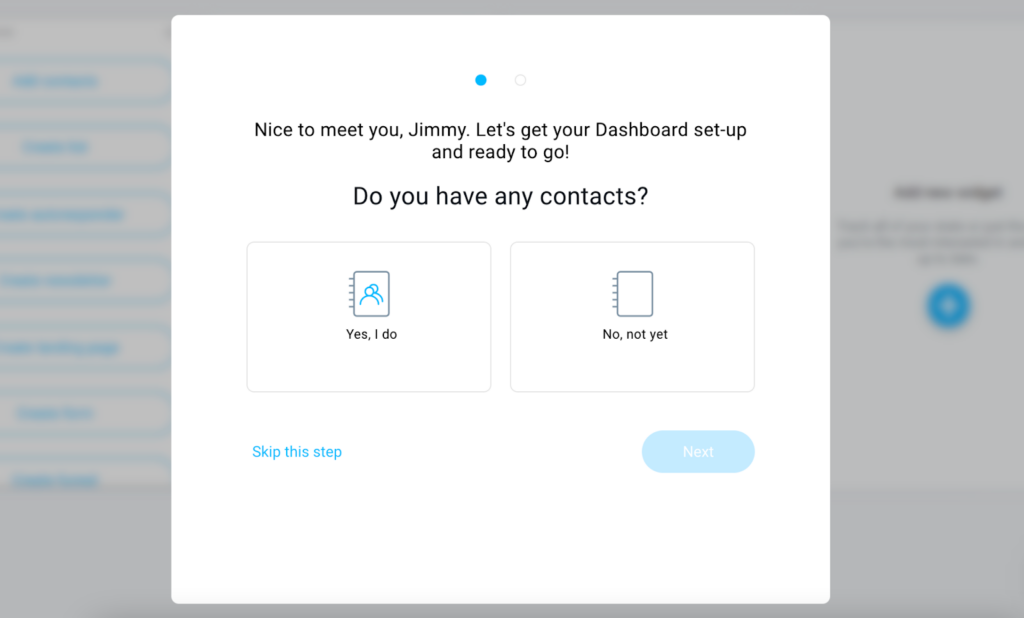
GetResponse streamlines onboarding by using automated email sequences to guide new users. Their setup wizard walks users through key steps, like creating a campaign and importing contacts. The platform’s AI-powered recommendations also suggest workflows based on user goals, accelerating activation.
TikTok (How Viral Apps Onboard Users Fast)
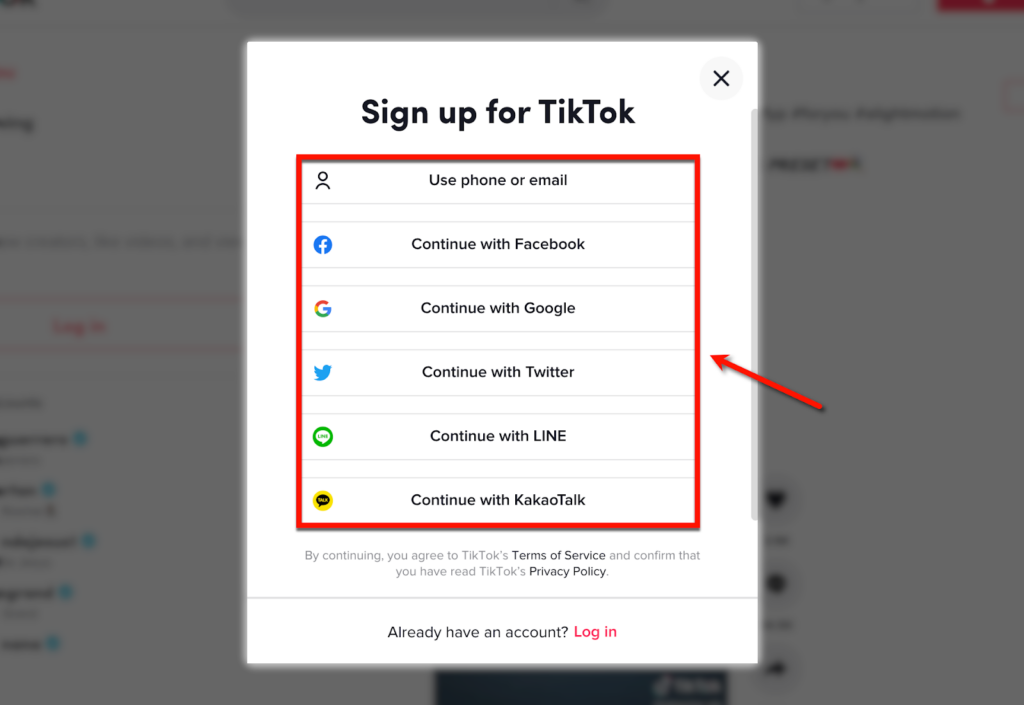
TikTok’s onboarding focuses on instant engagement and personalization. Instead of forcing users through a tutorial, TikTok curates a customized "For You" feed within seconds based on initial interactions, making onboarding feel seamless and habit-forming from the start.
Toggl (Gamification in Onboarding)
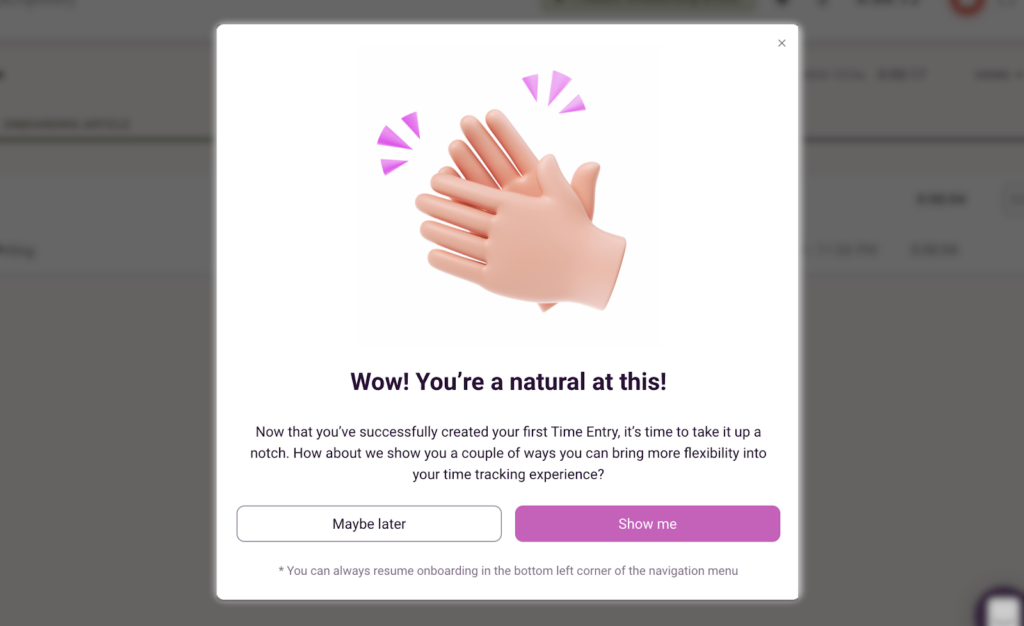
Toggl, a time-tracking tool, integrates gamification elements into onboarding. Users receive rewards, progress badges, and guided challenges that encourage them to explore features in an engaging way. This playful approach makes learning the tool fun and rewarding.
CoSchedule (Onboarding via Content Marketing)
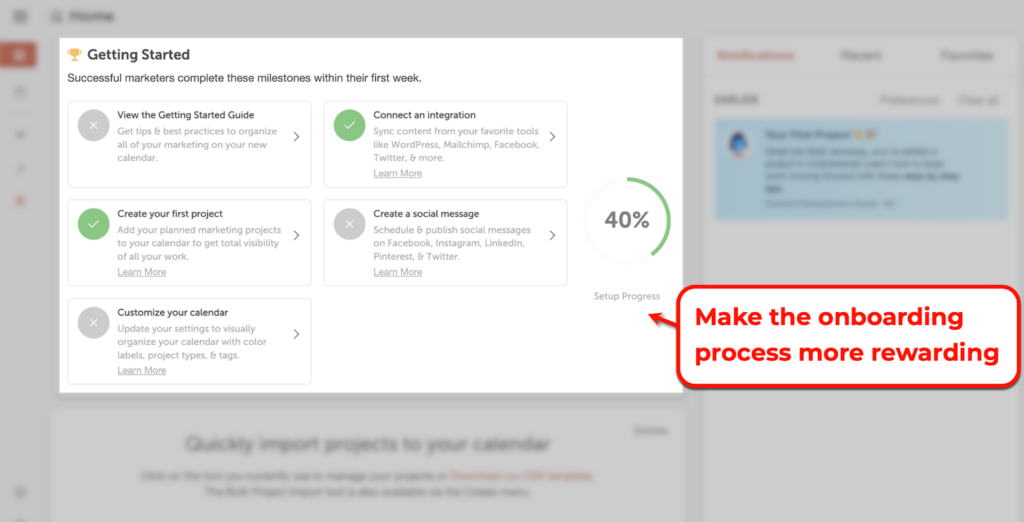
CoSchedule enhances onboarding with valuable content-driven onboarding. It provides tutorials, blog guides, and video walkthroughs to educate users on best practices. This approach helps users integrate CoSchedule into their workflow while reinforcing the product’s value.
Top Product Onboarding Tools
Choosing the right product onboarding tool is essential for user activation, engagement, and retention. Below are some of the best tools for different onboarding needs.
Product Fruits – Best for No-Code Interactive Walkthroughs

Product Fruits is an easy-to-use, no-code onboarding solution designed for businesses that want to create interactive walkthroughs, tooltips, and product announcements without developer assistance. It helps teams enhance onboarding experiences with in-app guidance and real-time feature updates.
Key Features:
✔ Drag-and-drop editor for building walkthroughs and tooltips without coding
✔ In-app announcements to highlight new features and updates
✔ Built-in user feedback collection to optimize the onboarding process
✔ Progress checklists to guide users through key steps
✔ Analytics dashboard to track feature engagement and adoption rates
Userpilot – Best for Personalized, Behavior-Driven Onboarding
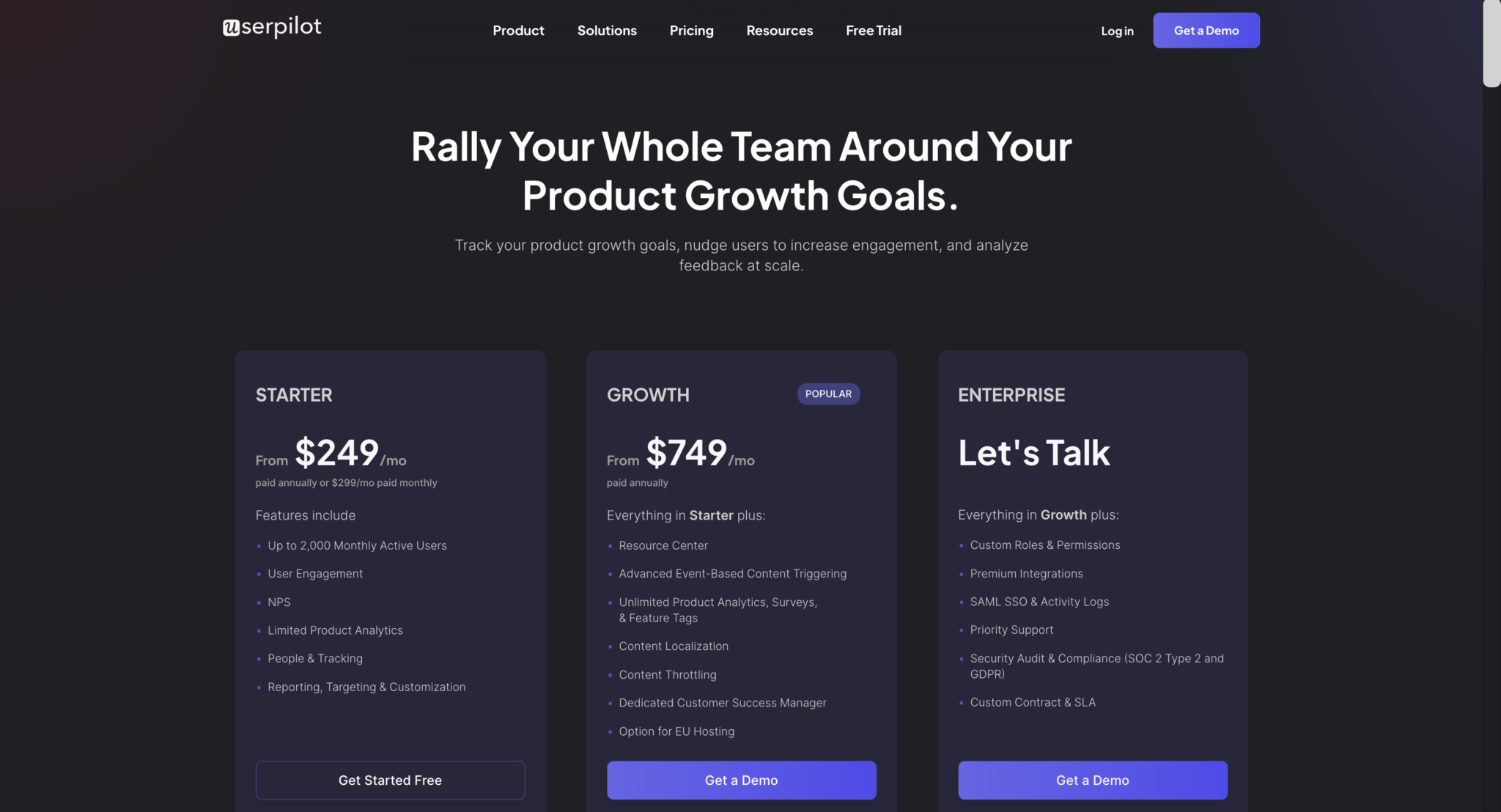
Userpilot specializes in goal-based onboarding by delivering personalized, role-specific experiences for new users. It allows businesses to create interactive product tours, feature adoption nudges, and in-app surveys.
Key Features:
✔ No-code editor for building interactive walkthroughs and tooltips
✔ AI-powered segmentation to personalize onboarding flows
✔ Feature adoption analytics to track how users engage with onboarding steps
✔ Contextual pop-ups and modals for targeted user engagement
✔ Supports multi-language onboarding for global users
Appcues – Best for In-App Onboarding & Engagement
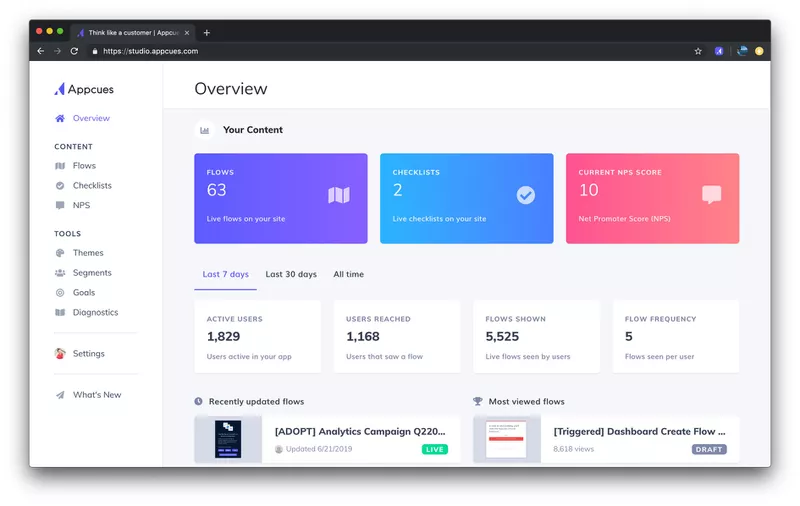
Appcues enables businesses to create customized product walkthroughs, in-app messaging, and behavioral-triggered guidance without requiring developer input. It’s ideal for in-app engagement and feature adoption.
Key Features:
✔ Drag-and-drop UI for building in-app flows and product tours
✔ WYSIWYG Chrome extension for editing UI patterns live
✔ Event tracking and analytics to measure engagement
✔ Custom user segments based on behavior and properties
✔ Supports NPS surveys and onboarding checklists
Pendo – Best for Product Analytics & In-App Guidance
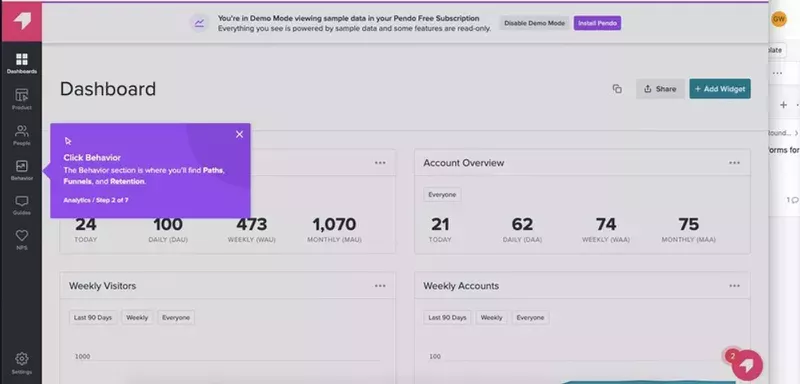
Pendo is a comprehensive product analytics and onboarding platform that combines in-app tutorials, behavioral tracking, and customer insights to improve feature adoption and retention.
Key Features:
✔ AI-powered insights to identify onboarding friction points
✔ No-code walkthrough builder for creating step-by-step guidance
✔ In-app surveys and feedback forms to collect user insights
✔ Behavioral segmentation to personalize the onboarding experience
✔ Heatmaps and analytics to track user engagement
Help Scout – Best for Self-Service Onboarding & Knowledge Bases
Help Scout provides knowledge base management, automated help widgets, and proactive support tools to enable self-service onboarding. It helps users find answers quickly without needing live support.
Key Features:
✔ AI-powered knowledge base for self-service support
✔ Automated onboarding emails with product tutorials and FAQs
✔ Live chat integration for real-time guidance
✔ Customizable help widgets for in-app assistance
✔ User activity tracking to analyze engagement
Omnisend – Best for Automated Onboarding Emails & Retention
Omnisend is a marketing automation platform that specializes in onboarding emails, SMS reminders, and push notifications to keep users engaged throughout their onboarding journey.
Key Features:
✔ Pre-built automation workflows for onboarding, retention, and engagement
✔ AI-powered segmentation to send personalized onboarding emails
✔ Multi-channel communication via email, SMS, and push notifications
Conclusion
A well-structured onboarding experience is key to user activation, retention, and long-term engagement. Product onboarding should be interactive, personalized, and friction-free to ensure users quickly experience value. Tools like Product Fruits simplify this process with no-code interactive walkthroughs, tooltips, checklists, and real-time feature updates, helping businesses create seamless onboarding experiences without developer assistance. With built-in user feedback collection and analytics, Product Fruits empowers teams to continuously improve onboarding and drive higher product adoption. Start optimizing your onboarding with Product Fruits today!





